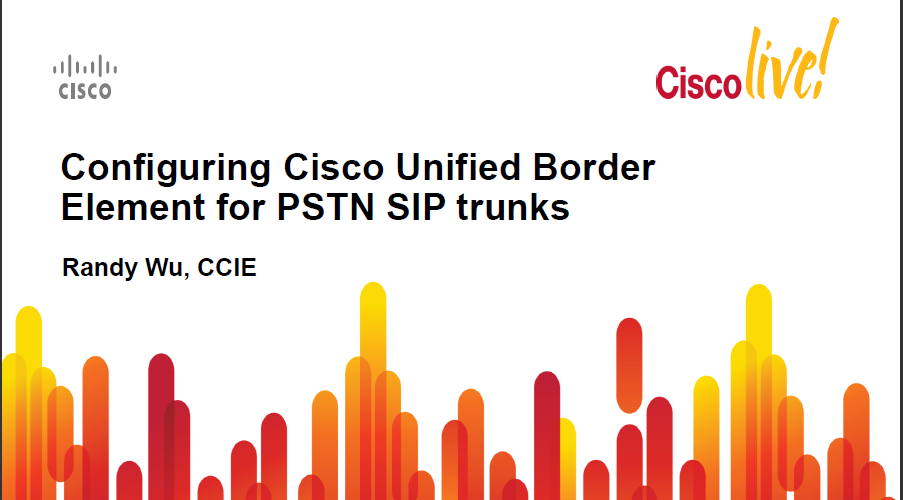- Cisco Community
- Technology and Support
- Collaboration
- Collaboration Knowledge Base
- Cisco Unified Border Element for PSTN SIP trunks: FAQ from live webcast
- Subscribe to RSS Feed
- Mark as New
- Mark as Read
- Bookmark
- Subscribe
- Printer Friendly Page
- Report Inappropriate Content
- Subscribe to RSS Feed
- Mark as New
- Mark as Read
- Bookmark
- Subscribe
- Printer Friendly Page
- Report Inappropriate Content
08-01-2011 02:28 AM - edited 03-12-2019 09:39 AM
Introduction

Randy Wu is a senior customer support engineer in the Multiservice Voice team at Cisco in Sydney. He has vast experience and knowledge configuring, troubleshooting, and designing Cisco UBE, gateways, and gatekeepers, working with H323, MGCP, and SIP protocols. He joined Cisco as a systems engineer in 1999. He holds CCIE certification (#8550) in Service Provider, Routing, and Switching and Voice.
The related Ask The Expert sessions is available here - Cisco Unified Border Element for PSTN SIP Trunks.
Click the Snapshots to view the Complete Recording of this live Webcast.
Configuring Cisco Unified Border Element for PSTN SIP trunks
Q: Would a CUBE ever be required in a CUCME (ISR) or UC500 deployment?
A: If you only have one UC or CUCME, then you may not want to have cube unless you have other features like security. But if you have mutiple UC or CUCME sites, but have only one SIP Provider. Then CUBE can be part of your network.
Q: What would be the minimum CUCM version to support CUBE? I have 7.1.5
A: CUCM 4.x has very limited support. CUCM Sip trunk integration with CUBE become more richer with CUCM version 5.x and 6.x. CUCM 8.5 version onwards Sip stack was developed more matured. It is recommended to use CUCM latest version to integrate with the Cisco CUBE.
Q: Can I download the presentation on Cisco website?
A: Yes you can download from this link,
https://supportforums.cisco.com/docs/DOC-17616
Q: Is there a Graphical configuration of CUBE exist ?
A: There is the Cisco Configuration Professional CCP 2.3 version which has the Graphical tool to configure CUBE.
Q: Can we use delayed-offer to early offer interworking on the CUBE?
A: Yes, Cisco UBE can do the early offer even if receives call from CUCM with delayed offer.
Q: If a sip based fax server is implemented...is it best practice to configure a sip trunk from the cube to the fax server directly or continue to send the calls through Cucm?
A: Both kind of Integration is supported. It will be based on the previous design of your network. If you already have SIP based fax server connected to CUCM its better to retain the configuration and dialplan, then you can integrate the CUCM trunk to CUBE.
Q: If i have delayed offer from my CUCM without the SDP, can I use CUBE to send out multiple codecs as early offer?
A: Cisco CUBE can do the Delayed offer to Early offer convertion. In CUBE there is a parameter under dial-peer called codec offer-all. so even if you got delayed offer from CUCM without SDP, on the other side CUBE can handle and send the codecs as early offer with SDP.
Q: Is call quality the only reason G711 is recommended over G729? The increased bandwidth requirement for G711 is an issue in many areas.
A: Minimizing the transcoding resource usage is another reason to use G711 with CUBE.
Q: Cube will not be able to use xcoder registered to CUCM?
A: CUBE is not able to use xcoer registered to CUCM, however you can configure DSP resource on CUBE itself and register to itself, hence CUBE will have available xcoder resource.
Q: How about configuring a CUBE to 2 SIP services from the same provider for redundancy?
A: With new features & command, it will allow user to configure CUBE pointing to different SIP service providers for redundancy.
Q: What Platforms are supported for CUBE?
A: Cisco CUBE is an Integrated application with Cisco IOS software. CUBE functionality is supported in ISR 3800 series, ISR G2 series 3900 and 2900 series, AS5400, AS5400XM universal gateways and the Service Provider Gateways ASR1000 series.
Q: Will you be able to confirm whether DTMF payload type is included in the SDP message (i.e. if MTP required checkbox is selected in CUCM SIP trunk setting) ?
A: Yes. If you select the MTP checkbox in the CUCM SIP trunk setting, and in the MTP configuration there is DTMF RFC2833 supported then in the SDP message DTMF payload type will be included.
Q: Can you elaborate on when CUBE SP edition vs standard edition is required?
A: CUBE SP edition is mainly used in the Service Provider network or large Enterprise network facing Service Provider to handle more voice sessions and high CPS ,for Enterprise Standard edition it will handle less of the sessions and low CPS. For SP level ASR CUBE supports up to 68000 sessions and 350 CPS in the high end box, for enterprise level it supports less sessions around 15000 and 50-150 CPS depending on the platform. In addition, the concept and configuration of CUBE SP edition is different than the Enterprise edition, please check ASR SBC 1000 series on CCO for more information of CUBE SP edition.
Q: What needs to be configured in the callmanager SIP trunk (v8.x) to remove the Delayed offer to Early offer from the CUBE and have the callmanager produce Early offer sessions?
A: From CUCM 8.5 onwards , In CUCM SIP Trunk profile there is an option to enable the Early Offer and you dont even need to have the MTP resource. But in Pre-CUCM 8.5 versions you need to check the MTP box and make sure the Media resource is allocated in CUCM, then you can do the Early offer from CUCM to CUBE.
Q: What are your thoughts about using H323 between UCM and CUBE, then use SIP between CUBE and the SIP Provider?
A: Refer the Best practises for using Cisco CUBE in the presentation link attached. From later CUCM 6.x onwards its recommended to use SIP for CUCM and Cisco CUBE. From choosing the Service Providers point of view, if the Provider can support SIP it will be better, but some providers only support H.323. In such case you have to use H.323 for integration.
Q: We have 49 indidual PSTN line how is it possible to convert in digital trunk?
A: Yes, you can convert to SIP trunk. You need to make sure provider can have all the functionalities like DID number etc. CUBE has no problem migrating to it.
Q: Can u pls explain how many pstn connection support CUBE
A: If SIP provider requires regisration, then there is limitation. But if CUBE's limit is number of session for simultenous call. and number of call is limited depending platform you'll use
Q: Is it planned that CUBE will be able to manage directly MTP resources inside the box for third-party PBX interoperability?
A: CUBE does support managing MTP resources inside the box.
Q: Does CUBE support authentication of incoming INVITEs from SP?
A: CUBE does support authentication of invite from SP with latest feature.
Q: What is the licensing requirements of the Cube?
A: If you have any existing Cisco Gateway then you can download the Cisco IOS supported version for running CUBE on your Gateway. Also you need to buy license for the no. of sessions in CUBE for different platform. Say for an example if you want to have a CUBE supporting 500 sessions , you need to buy the license for this amount.
Q: Can CUBE forward presence subscriptions from PBX to SP?
A: With latest CUBE 8.8 version, It can pass through most of the messages
Q: SIP-H323 interworking only supports voice or both voice and video?
A: SIP-H323 interworking only support voice, not video yet.
Q: How many digital trunk support CUBE?
A: CUBE voice call sessions are based on IP, the number of digital trunks depends on the performance of the CUBE platform, it can be up to 15000 sessions or even 68000 sessions in ASR platform
Q: Whether CUBE supports Voice and Data traffic simultaneously?
A: Yes. CUBE is in IOS based platform hence it can handle both Voice and Data traffic.
Q: Can Cisco CUBE support Interactive Voice Response system?
A: Yes. CUBE can work with TCL IVR script and Voice Xml application to provide IVR capability to IP calls.
Q: What are some of the "gotchas" we should look out for when ordering sip service from a carrier such as caller id and supplementary services etc.
A: Supplementary service , connection address c=0.0.0.0 or send for hold, privacy, ANI etc couple of things you can look for. Also, 180 or 183, reinvite, session refresh causes some issue.
Q: How many call can CUBE handle at a time?
A: It is depend on whether we are configuring media flow around or flow through, if it flow around then max session come up to 1000+ for flow through it may up to around 500 with cpu usage of 80%. (for ISR G2 platform, not including ASR platform)
Q: For authentication of INVITEs from SP, is it only a dial-peer configuration, or should it be globally enabled first?
A: Authentication has to be globally enabled. It will be under the global voice service configuration. Both registration and authentication can be defined under the voice services.
Q: If security is not a concern, can you not use the CUBE and use a normal voice gateway?
A: CUBE is just a functionality on GW, if you have normal GW connects to SIP Provider and then goes to another IP Leg like CVP or CUCM, it its the CUBE funcationality. You can use ISR or other GW with CUBE functionality IOS.
Q: Does CUBE have to be run on a dedicated device/router?
A: Not Necessary. It depends on the voice traffic you want to route using CUBE. For large enterprise its recommended to use standalone device for CUBE functionality. If the traffic is not high you can run other services along with the CUBE application for voice on the same platform simultaneously.
Q: How many FXO can support CUBE?
A: It is depend on whether you would like to install FXO on the router to turn it to a TDM gateway at the same time, you can install number of FXO ports based on whether there is enough DSP and slots.
Related Information:-
Find answers to your questions by entering keywords or phrases in the Search bar above. New here? Use these resources to familiarize yourself with the community:
